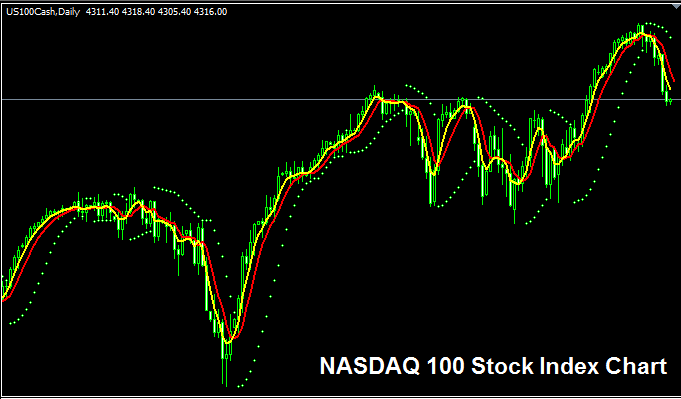NASDAQ 100 Index
The NASDAQ 100 is an index that includes 100 of the largest companies listed in the NASDAQ stock exchange market that are not in the financial sector. The calculation of this index is based on weighted factor of market capitalization of the listed 100 securities. The 100 companies listed on this index are reviewed quarterly.
The 100 companies used to calculate this index are not necessarily based in the USA; foreign international companies are also included as long as they are listed in the NASDAQ Stock Exchange.

The NASDAQ 100 Index Chart
The NASDAQ 100 Index chart is shown above. On the example above this stock index is named as US100CASH. As a trader you want to find a broker that provides this The NASDAQ 100 Index chart so that you can start to trade it. The stock index example above is of NASDAQ 100 Index on the MetaTrader 4 Forex and Stock Indices Trading Platform.
Other Information about NASDAQ 100 Index
Official Symbol - QQQ:IND
The 100 component stocks that make up the NASDAQ 100 Index are calculated using a weighted factor for each stock. The component stocks and weighting for each stock is reviewed quarterly.
Strategy for Trading NASDAQ 100 Index
The NASDAQ 100 Index method of calculation makes it more volatile hence there are more wide swings in the price movements of this index. The Index has a weighting factor for each stock included on this index. Although this index generally moves up over the long term because the American economy also shows strong growth.
As a trader you want to be biased and keep buying as the index moves up. When the USA economy is doing well, the stocks that make up the NASDAQ 100 index will keep gaining in values and thus this index is likely to keep moving in an upward trend. A good strategy to trade this Index would be to buy the dips.
During Economic Slow Down and Recession
During economic slowdown and recession times, companies start to report lower profits and lower business growth prospects. It is due to this reason that investors start to sell stocks of companies reporting lower profits and therefore the stock index tracking these particular stocks will also start to move downwards.
Therefore, during these times stock index trends are likely to be heading downwards and as a trader you should also adjust your trading strategy accordingly to fit the prevailing downward trends of the stock market index that you are trading.
Contracts and Specifications
Margin Required Per 1 Lot - $ 30
Value per 1 Pip - $ 0.1
Note: Even though the general trend is generally upwards, as a trader you have to factor in the daily market volatility, on some days the stock index may oscillate or even retrace, the stock index market retracement may also be significant at times and therefore as a trader you need to time your entry precisely using this strategy: Stock indices trading strategy and at the same time use proper money management rules just in case of more unexpected volatility in the market trend. About money management rules in index trading topics: What is stock index money management and stock index money management methods.
